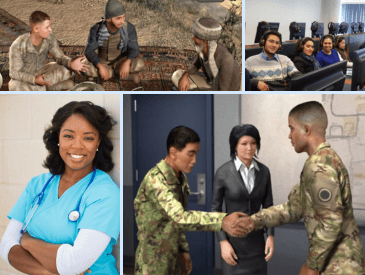
What is the most effective way to prepare for a new job? This is a critical question for employers who are inducting new employees and want them to be ready on day 1. Workers who are reskilling or upskilling to qualify for new jobs want to be sure that their training is adequately preparing them.
Conventional slideshow presentations and training videos do not give learners the opportunity to practice skills, and this limits their effectiveness. Companies are therefore increasingly looking at artificial intelligence (AI) and virtual reality (VR) to improve their training. We at Alelo have experience with both AI and VR technologies and have concluded that conversational AI is the most important component technology. It is more versatile than VR and can overcome the scalability and quality problems that VR solutions are prone to. Given the choice, our customers tend to choose AI-driven avatars over VR solutions.
AI-driven avatars, also known as pedagogical agents, incorporate natural language processing technology so that they can interact with trainees in a natural way. Trainees can role-play work scenarios, with avatars playing the role of customers or co-workers. They can also talk through procedures with avatar co-workers, explaining and answering questions. This combines the benefits of learning by doing and learning by teaching. Learning by doing has been shown to be six times more effective than learning by watching and reading. Learning by teaching someone else, known as the protégé effect, results in better learning than learning just for yourself.
For example, a mining operations company recently came to us with a difficult employee induction problem. Occupational safety, also known as zero harm, is critical for mine operations. Conventional training methods were not solving the problem; workers were not retaining information from training manuals and presentations, and the workers tended not to take them seriously. Many large mining companies are investing in virtual reality systems for training, but our customer recognized that a VR experience in a virtual mine does not necessarily prepare workers to work safely in a real mine. If they make safety mistakes in the virtual mine and do not get feedback, they are likely to make the same mistakes in the real mine.
By contrast, Alelo designed an avatar-based training solution in which trainees talk through safety procedures with an avatar co-worker, and practice safety-related procedures. Driven by AI and natural language processing, the avatar co-worker can identify the worker’s incorrect knowledge on procedures and provide immediate correction in only those areas. The solution runs on the worker’s tablet device, so they can refer to it anywhere–before they arrive at the job site, above ground at the job site, and even underground in the mine. VR-based solutions cannot possibly offer that kind of usage flexibility. Built-in data collection and analytics help the mine operator ensure that all trainees have mastered the core competencies of mining operations.
AI-driven avatar technology also has the potential to integrate with and enhance VR technology. In fact, we were the first group to integrate AI-driven avatars into VR training systems. As VR-based training becomes more widespread, there will be an increasing need for AI-driven avatars in such systems. Otherwise, human operators must be available at all times to control the avatars. This limits the scalability of VR solutions, and the quality of training can suffer if well-trained avatar operators are not available.
Related Article: Conversational AI vs. VR in Training



About The Author
Lewis Johnson
Dr. W. Lewis Johnson is President of Alelo and an internationally recognized expert in AI in education. He won DARPA’s Significant Technical Achievement Award and the I/ITSEC Serious Games Challenge, and was a finalist in XPRIZE Rapid Reskilling. He has been a past President of the International AI in Education Society, and was co-winner of the 2017 Autonomous Agents Influential Paper Award for his work in the field of pedagogical agents. He is regularly invited to speak at international conferences for distinguished organizations such as the National Science Foundation.